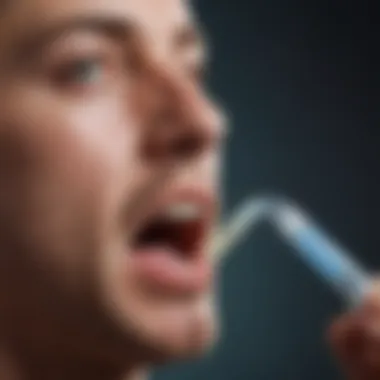Brushing Teeth Before H. Pylori Breath Test: Key Insights


Intro
The H. pylori breath test serves as a critical tool in diagnosing Helicobacter pylori infections. These infections are recognized for their link to several gastric disorders, including ulcers and chronic gastritis. The accuracy of the test can heavily rely on pre-test protocols, especially personal oral hygiene habits. A common concern among patients is whether brushing teeth prior to the test can affect the results. Understanding these considerations is essential for anyone preparing to undergo the breath test.
Article Overview
Purpose of the Article
The primary objective of this article is to dissect the protocol surrounding the H. pylori breath test with a focus on tooth brushing practices. It aims to clarify misunderstandings and provide clear guidelines to patients. By synthesizing current research and clinical recommendations, the article intends to enhance compliance with testing protocols, thereby ensuring the reliability of test outcomes.
Relevance to Multiple Disciplines
This subject has implications in various fields, such as gastroenterology, dentistry, and public health. For gastroenterologists, understanding the factors that might compromise test accuracy is essential. Dentists also find relevance in educating patients about the implications of oral hygiene and its potential influence on gastrointestinal health. Furthermore, public health educators can use this information to promote better health-seeking behaviors among patients.
Research Background
Historical Context
Helicobacter pylori was first discovered in 1982 by Barry Marshall and Robin Warren, revolutionizing the understanding of gastric diseases. The establishment of the H. pylori breath test in the following years offered a non-invasive diagnostic alternative. Developed to measure the amount of carbon dioxide in exhaled breath, this test reflects the presence of urease, an enzyme produced by H. pylori.
Key Concepts and Definitions
To appreciate the nuances of the H. pylori breath test, it is crucial to define some key concepts:
- Helicobacter pylori: A type of bacteria that can inhabit the stomach lining and lead to various digestive disorders.
- Breath Test: A non-invasive procedure that measures byproducts of H. pylori activity in the stomach.
- Urease: An enzyme produced by H. pylori that breaks down urea into ammonia and carbon dioxide, which is detectable in the breath test.
This article will delve into the proper protocols, specifically concerning oral hygiene, underscoring its pertinence to successful test results.
Foreword to H. Pylori and Its Implications
The discussion surrounding Helicobacter pylori, commonly known as H. pylori, is crucial for comprehending its health implications and the various diagnostic methods available. This bacterium is not only a primary cause of numerous gastrointestinal disorders but also serves as a focal point in gastrointestinal health research. Understanding H. pylori and its implications informs both patients and healthcare professionals about the risks associated with infection and the necessary steps to diagnose it effectively. One significant diagnostic tool used in detecting H. pylori is the breath test. Therefore, knowing the implications of rate of this test is fundamental.
Overview of Helicobacter Pylori
Helicobacter pylori is a gram-negative bacterium that primarily resides in the stomach. It is found in nearly half of the global population, which underscores its prevalence. This microorganism is associated with chronic inflammation of the stomach lining, known as gastritis, and is a well-known factor in the development of peptic ulcers. H. pylori can survive in the harsh acidic environment of the stomach by producing an enzyme called urease, which neutralizes stomach acid, facilitating its survival.
Clinical complications from H. pylori infection can range from mild gastritis to more severe outcomes like gastric cancer. Recognizing the characteristics of this bacterium and understanding how it affects the gastrointestinal system is vital in discerning effective treatment plans and preventive measures. Furthermore, the presence of H. pylori fosters a complex interplay with the body's immune system, elevation of gastric inflammation, and disruption of the microbiota, leading to various disorders.
Gastrointestinal Disorders Associated with H. Pylori
The relationship between H. pylori and gastrointestinal disorders is evident in multiple clinical studies. Here are key disorders linked to H. pylori infection:
- Peptic Ulcer Disease: H. pylori is a major contributing factor to both gastric and duodenal ulcers. The bacterium damages the mucus layer that protects the stomach lining. This damage facilitates ulcer formation.
- Chronic Gastritis: Persistent presence of H. pylori in the stomach leads to chronic gastric inflammation, with symptoms including nausea, abdominal pain, and bloating.
- Gastric Cancer: Prolonged infection with H. pylori is recognized as a significant risk factor for gastric cancer. Epidemiological studies suggest that H. pylori-related chronic gastritis can progress to cancer in a subset of patients.
- MALT Lymphoma: This is a rare type of gastric cancer that can develop in cases of H. pylori infection, particularly affecting the mucosa-associated lymphoid tissue.
A nuanced understanding of these disorders emphasizes why timely and accurate testing for H. pylori is imperative. The breath test serves as an excellent non-invasive diagnostic means, enhancing patient comfort while yielding crucial insights into the presence of this bacterium. A comprehensive approach to related conditions, combined with awareness of the impact of oral hygiene on testing protocols, helps ensure better diagnostic accuracy and patient outcomes.
Understanding the H. Pylori Breath Test
The H. pylori breath test is a vital diagnostic tool for detecting infections caused by Helicobacter pylori. Understanding this test is crucial for anyone preparing for it. Properly navigating the test's protocol ensures accurate results, which is essential for effective treatment. Consequently, familiarity with the purpose and procedure of the breath test adds great value to the patient's experience and outcome. By grasping these elements, one can minimize any anxiety surrounding the test while maximizing its effectiveness.
Purpose of the Breath Test
The primary purpose of the H. pylori breath test is to identify the presence of Helicobacter pylori in the stomach. This bacterium is often linked to several gastrointestinal disorders, including peptic ulcers and gastritis. The breath test works by measuring specific chemical compounds produced when the bacteria metabolize urea.


This non-invasive method offers several significant advantages:
- Accuracy: It is highly accurate compared to other methods such as blood tests, which may show false positives.
- Non-invasive: There is no need for endoscopy, making it more comfortable for the patient.
- Quick results: Test results are often available within a short timeframe, facilitating faster treatment decisions.
Overall, the breath test is an essential step in diagnosing H. pylori infections, guiding appropriate therapeutic interventions.
Procedure of the Breath Test
The procedure for the H. pylori breath test is straightforward yet requires careful adherence to protocol. Typically, the process involves several key steps:
- Preparation: Patients must follow specific pre-test instructions, which may include dietary restrictions and medication considerations.
- Baseline Sample Collection: Initially, a baseline breath sample is taken. This step is critical as it helps gauge the patient's normal breath composition.
- Ingestion of Urea Solution: The patient then drinks a solution containing urea labeled with a special carbon isotope (usually C-13 or C-14).
- Post-Ingestion Sampling: After a set time, usually around 30 minutes, another breath sample is collected to analyze the presence of carbon dioxide produced by the Helicobacter pylori.
The entire process usually lasts about an hour. Patients are advised to stay relaxed and follow the instructions provided by healthcare professionals to ensure optimal accuracy of results. The test’s simplicity and efficiency contribute to its widespread use in clinical practice.
Pre-Test Preparation
Pre-test preparation is a critical phase when it comes to ensuring the accuracy of the H. pylori breath test. As this test serves to diagnose an infection that can lead to serious gastrointestinal issues, understanding the preparation involved is essential. Proper preparation mainly focuses on two significant aspects: dietary restrictions and the impact of medications. Each contributes to creating a suitable environment in which the test can yield reliable results.
Dietary Restrictions
Dietary restrictions serve as an essential part of pre-test preparation for the H. pylori breath test. Patients are usually advised to avoid certain foods and beverages that might interfere with the test results. This is because some substances can influence the breath sample or alter the normal function of the digestive system.
Key dietary considerations include avoiding:
- Sugary foods: High sugar intake can encourage bacterial growth, which may skew test outcomes.
- Dairy products: These can impact the bacteria's activity in the stomach, potentially leading to misleading results.
- Caffeinated beverages: Coffee or tea can stimulate gastric acid production and alter microbial dynamics.
- Alcohol: It can affect test accuracy by changing gut flora and interfering with the stomach lining.
Generally, patients should refrain from these foods at least 24 hours before undergoing the test. This helps create an optimal condition for accurate measurement of breath samples. The importance of adhering strictly to these dietary guidelines cannot be overstated. Ignoring these restrictions may lead to false negative or positive results, causing complications in diagnosis and treatment.
Impact of Medications
The impact of medications on the H. pylori breath test is another vital consideration. Specific medications can either directly affect Helicobacter pylori or modify gastric conditions, thereby influencing the results of the test.
Common medications that should generally be avoided include:
- Proton pump inhibitors (PPIs): Drugs like omeprazole and lansoprazole reduce stomach acid production, which can hinder the growth of H. pylori, possibly yielding false negatives.
- Antibiotics: These can eradicate H. pylori bacteria, which will also lead to inaccurate test results. It's advisable to avoid such medications at least four weeks before the test.
- Bismuth compounds: Medications like Pepto Bismol can similarly impact the bacteria's activity, leading to unreliable outcomes.
Patients must communicate openly with their healthcare provider regarding all medications they are currently taking. This allows for proper guidance on how long prior to the test they should discontinue specific medications, ensuring an accurate diagnosis of H. pylori infection.
It is crucial for patients to strictly follow pre-test preparation guidelines to facilitate effective testing and appropriate treatment.
It is crucial for patients to strictly follow pre-test preparation guidelines to facilitate effective testing and appropriate treatment.
In summary, pre-test preparation for the H. pylori breath test cannot be neglected. Proper dietary restrictions and a review of medications are fundamental to ensure that the test results accurately reflect a patient’s H. pylori status. Ultimately, attention to these details aids in guiding effective treatment and improving patient outcomes.
Tooth Brushing Before the Test
Tooth brushing before the H. Pylori breath test carries significant implications for the accuracy of the results. Maintaining good oral hygiene is generally beneficial for overall health, but when it comes to this particular diagnostic procedure, the timing and method of brushing can impact the outcomes. This section discusses the necessity of considering oral hygiene practices, emphasizing the potential consequences of brushing one’s teeth immediately before the test.
Rationale Behind Pre-Test Oral Hygiene
The rationale for maintaining oral hygiene prior to the H. Pylori breath test lies in the potential contamination of saliva and breath samples. Bacteria from dental plaque could be released into the sample if teeth are brushed hastily before the test, leading to inaccurate readings. The presence of other bacteria, notably those not related to H. Pylori, could obscure the results, complicating the physician's interpretation of the data.
Moreover, brushing teeth can alter the natural balance of oral microbiota. H. Pylori is typically present in the stomach and may not be easily detected if other bacteria overwhelm the sample. Evidence suggests that adhering to specific oral hygiene guidelines can help in achieving more precise readings and thus more appropriate medical recommendations.
Additionally, there are considerations regarding the toothpaste or dental products used. Many commercial toothpaste brands contain substances that may interfere with the breath test results, such as high levels of fluoride or other antibacterial agents. These could potentially skew the test outcomes, highlighting the need for cautious oral hygiene practices prior to testing.


Expert Recommendations
Experts offer varying recommendations regarding tooth brushing before the breath test. Many healthcare professionals advocate for brushing teeth at least 12 hours prior to the test, allowing for the natural reestablishment of oral bacteria. Following this guideline can help mitigate contamination risks while ensuring that the sample accurately reflects the current state of the stomach.
In addition to timing, the choice of oral hygiene products is another vital aspect to consider. Using a non-fluoride toothpaste or even opting for plain water rinses instead of conventional brushing is suggested by some specialists. The aim is to reduce any possible interference that might arise from the chemical composition of the products.
Ultimately, patients should seek guidance from their healthcare provider regarding the best practices for oral hygiene before the H. Pylori breath test. Clear communication of one’s routine and any products used will enable healthcare professionals to offer tailored recommendations that align with the patient's unique situation.
Key point: Avoid tooth brushing immediately before the H. Pylori breath test to reduce the risk of contamination and improve the accuracy of results.
Key point: Avoid tooth brushing immediately before the H. Pylori breath test to reduce the risk of contamination and improve the accuracy of results.
Potential Effects of Tooth Brushing
Tooth brushing plays a significant role in oral hygiene, which is why its implications before the H. pylori breath test must be considered closely. The focus on tooth brushing before the test is crucial to ensure that test results remain accurate and reflective of the individual's true Helicobacter pylori status. There are specific effects that brushing can have that may influence the results of this diagnostic procedure.
Contamination Risks
One of the primary concerns regarding tooth brushing before taking the H. pylori breath test is the potential for contamination. When teeth are brushed, it is possible that traces of toothpaste or even microorganisms from the mouth can inadvertently enter the breath sample. This can lead to misleading results, as foreign substances may interfere with the chemical reactions measured during the test.
Here are some key points regarding contamination risks:
- Toothpaste Residue: Many toothpastes contain ingredients like flavoring agents and sweeteners. These components can alter the readings of the breath test.
- Microbial Transfer: Brushing may dislodge bacteria in the mouth. If certain bacteria are mistaken for H. pylori, it can lead to false positives.
- Timing Factors: The timing of brushing can be vital. If done too close to the test, effects may not dissipate in time for accurate results.
For these reasons, caution is recommended. It is advisable to follow specific guidelines about oral hygiene leading up to the test to avoid contamination issues that might skew results.
Changes in Oral Microbiota
Tooth brushing can also induce changes in oral microbiota, another important consideration for the H. pylori breath test. The oral microbiome is a complex ecosystem of microorganisms living in the mouth. Altering this balance through brushing may diminish the reliability of the test.
Key aspects to consider include:
- Flora Disruption: Regular brushing removes plaque and bacteria, which can change the population of microorganisms present. This shift is noteworthy, as certain bacteria can influence the metabolite levels measured during the breath test.
- Immediate Aftereffects: After brushing, levels of particular bacteria may decrease temporarily. If any of these are crucial for accurate test results, their absence or reduced presence might lead to incorrect interpretations.
- Cultural Variation: Different brushing techniques and frequencies may contribute to unique oral microbiota profiles, underscoring the importance of standardized pre-test precautions.
In summary, while maintaining good oral hygiene is critical for overall health, the effects of tooth brushing before a H. pylori breath test raise significant concerns. Contamination risks and changes in oral microbiota are two main factors that can influence the validity of test outcomes.
Alternatives to Tooth Brushing
When preparing for the H. pylori breath test, it is essential to consider alternatives to tooth brushing. Oral hygiene plays a significant role in the reliability of test results. Many patients wonder about the best strategies for maintaining oral cleanliness without interfering with the breath test. This section discusses two effective alternatives: mouth rinses and dental floss or interdental cleaners.
Mouth Rinses and Their Impact
Mouth rinses can be a suitable substitute for tooth brushing before the breath test. They serve to cleanse the oral cavity effectively, removing food particles and reducing potential bacteria. However, it is crucial to choose the right kind of mouth rinse.
- Non-alcoholic options: Alcohol-based mouthwashes may affect oral microbiota and could alter the bacteria present in the breath sample. Using a rinse that is alcohol-free minimizes these risks.
- Antimicrobial rinses: Some people might be inclined to use antimicrobial rinses for better oral hygiene. While these products can reduce harmful bacteria, their impact on test results should be considered. They can potentially skew results, as they might suppress H. pylori or other bacteria that are important to assess.
Overall, mouth rinses can offer a clean feeling and help to prepare the mouth without the need for brushing. However, using them responsibly and understanding their effects on test outcomes is vital.
Dental Floss and Interdental Cleaners
Dental floss and interdental cleaners provide another effective means for oral hygiene before the test. These tools can help in maintaining cleanliness between teeth, an area where toothbrushes may not reach adequately.
- Flossing: This is a simple and effective method to remove debris stuck between teeth. Regular flossing can contribute to better overall oral health.
- Interdental brushes: For some people, interdental brushes may be easier to use than floss. They can effectively clean wider gaps between teeth, ensuring that food particles do not compromise the breath test.
Using floss or interdental cleaners allows for the removal of buildup without affecting the oral microbiota as significantly as brushing might. It is a gentle yet effective compromise for patients preparing for the H. pylori breath test.


In summary, while tooth brushing is often discouraged before the H. pylori breath test, these alternatives offer practical options that can effectively maintain oral hygiene without compromising test results.
Consulting Healthcare Professionals
When preparing for the H. pylori breath test, consulting healthcare professionals is essential. They play a significant role in guiding individuals through the diagnostic process. A thorough understanding of the test requirements can alleviate concerns and enhance the accuracy of the results. Engaging with a healthcare provider allows patients to clarify any uncertainties regarding pre-test procedures, such as oral hygiene practices like tooth brushing.
Communicating Concerns
Effective communication is key when consulting with healthcare professionals about the breath test. Patients should express any worries regarding tooth brushing prior to testing. This can include concerns about the potential impact on test results. It is important to inquire whether the use of toothpaste or mouthwash might interfere with the breath test. Healthcare professionals can clarify these issues, helping to provide reassurance. By having open discussions, patients can better prepare for the examination, addressing any lingering doubts.
Following Best Practices from Providers
Healthcare professionals often have access to the latest research and guidelines regarding the H. pylori breath test. Following their advice ensures adherence to best practices. They may suggest specific oral hygiene recommendations to follow before the test. This could include refraining from brushing teeth with toothpaste for a certain period before testing.
Here are some examples of best practices to consider:
- Timing of Oral Hygiene: Follow recommendations on how long to wait after brushing before undergoing the test.
- Avoiding Certain Products: Discuss whether any specific products should be avoided before the test.
- Understanding Test Protocol: Gain a clear understanding of the testing process, including preparation steps.
By taking the time to consult healthcare providers, individuals can enhance their understanding of the H. pylori breath test and ensure they are adequately prepared.
What to Expect During the Test
The H. pylori breath test serves as a pivotal assessment tool for diagnosing Helicobacter pylori infection, and understanding what to expect during the test is essential. It encompasses not only the procedure itself but also the nuances that can affect the outcomes. Awareness involves grasping the patient experience and the importance of post-test follow-up.
Patient Experience
The patient experience during the H. pylori breath test is largely straightforward, yet many individuals approach it with a mix of uncertainty and apprehension. Upon arrival at the testing facility, practitioners usually begin by explaining the entire process. This reassurance is key; understanding the steps can ease anxiety.
Typically, the test starts with the patient providing a baseline breath sample. This initial sample is critical; it sets a reference point for subsequent measurements. The patient is then administered a urea solution containing a non-radioactive isotope. After a brief waiting period, usually around 15 to 30 minutes, the patient provides another breath sample.
It is important to remain still and follow instructions given by the healthcare provider during this time. The whole procedure takes about 30 minutes to an hour, depending on the facility and specific methods used.
Patients often ask about side effects or discomfort. Generally, there are minimal risks involved. Some individuals might experience mild nausea due to the urea solution, but this varies widely. Being well-informed allows patients to prepare mentally, which is beneficial for both comfort and cooperation during the process.
Post-Test Follow-Up
Following the test, post-test follow-up plays a substantial role in patient care. Results typically take a few days to be processed, and patients should be clear about how and when they will receive their results. This follow-up can occur through various means, such as phone calls or in-person appointments.
A crucial aspect of post-test communication is understanding the implications of the results. If the test is positive, healthcare professionals discuss the next steps, often prescribing antibiotics or other therapies. Patients are encouraged to ask questions and clarify concerns about the treatment plan and its potential side effects.
If the result is negative, it is still important to discuss any ongoing symptoms and consider further diagnostic tests if necessary. Knowledge is paramount, and knowing how to navigate the path post-test enhances patient engagement and adherence to treatment plans.
Communication is key: Establishing a dialogue with healthcare providers fosters trust and understanding, ensuring that patients make informed decisions about their health care journey.
Communication is key: Establishing a dialogue with healthcare providers fosters trust and understanding, ensuring that patients make informed decisions about their health care journey.
Ending and Recommendations
The conclusion of this article serves as a crucial summary, bridging the detailed explorations discussed in previous sections and reinforcing their significance in understanding the H. pylori breath test and the implications of tooth brushing prior to the procedure. The H. pylori breath test is a vital diagnostic tool, making it essential for accurate preparation before testing. The guidelines and considerations reviewed highlight the delicate balance between oral hygiene and test credibility.
A key element of this section is to emphasize that the recommendations provided aim at minimizing potential contamination and ensuring that the test results are reliable. This reduces the chances of false negatives or positives that may arise from improper oral care routines just before the examination. Following the appropriate protocols can significantly influence the outcome, making the test an accurate reflection of the patient’s helicobacter pylori status.
Summary of Key Points
- The H. pylori breath test requires specific preparation to achieve accurate results.
- Tooth brushing prior to the test can introduce variables that affect the accuracy of the results.
- Understanding the rationale behind pre-test oral hygiene helps patients make informed decisions.
- Consulting healthcare professionals for personalized advice is crucial.
Advice for Future Patients
- Communicate with Your Practitioner: Always discuss your oral hygiene practices with your healthcare provider before the test. This can provide tailored instructions suited to your specific circumstances.
- Follow the Guidelines: Adhere strictly to the dietary and medication restrictions outlined prior to the test. Ignoring these could impact the reliability of the results.
- Consider Alternatives: If you are worried about oral cleanliness after not brushing your teeth, explore safe alternatives to maintain oral hygiene without compromising test outcomes.
- Clear Your Doubts: If you have concerns about how your dental care may affect the test, do not hesitate to ask questions. Being informed will prepare you better for the experience.
By keeping these recommendations and summaries in mind, future patients can approach their H. pylori breath test with confidence in the reliability of their results, ensuring that any interventions required are based on accurate diagnoses.



